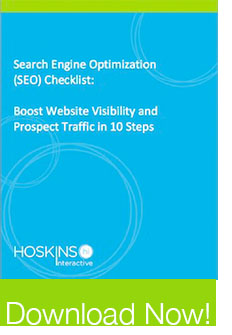Hoskins Interactive Media & Marketing Blog
Current Articles Rss FeedIt’s Cheaper Than a Redesign: Optimize Your Website, Get More Customers
Posted bywpbizTue, Jul 30, 2013 @ 2:06 pm
It usually comes up when I’m talking to a prospective client: website redesign. They believe this is the way to attract more traffic, generate phone calls, emails, interest in services… Guess what: it’s not necessarily true.
But it has been the practice of the past, so I can understand why small business owners think this is the path to take. Today the Web and the way to use it for business is much more sophisticated. It takes more than a nice looking website—lead generation is a process unto itself. But before you make a hefty investment, maximize what you’ve got. Let’s talk about how to create and assess your website pages so that they perform for you.
Think of your website as a digital storefront. Is information easy to find? Does it really help first time visitors understand who you are and what you, as an organization, can do for them? If your website pages could use a face lift, here’s how to refit them to attract attention.
What is the goal of the page?
Each page on your website should have a purpose. At a glance, is yours easy to discern? Design will really help with layout, the way content is arranged on the page. (I am a huge fan of design for this and other reasons). But at a minimum, consider how to use bullets, white space, images and bold font to tell your story in a way that doesn’t require much thought.
Not that easy, is it? This should help: focus each page around a goal. What do you want it to accomplish? For example:
- Home pages typically describe: who we are, what we do, where to go next.
- Product pages typically describe: features/benefits and the way to further engage. They outline what you get, how it helps you, how to learn more.
- Blog pages typically describe: free industry expertise, advice, sometimes entertainment.
Support the goal with content.
When you know what you want a specific page to do for you, it is easier to write and organize content. If your product is technical and complex, consider infographics and perhaps video to illustrate features and benefits.
Just remember to stick to your goal and give the visitor an action to take, a next step to find more information and keep them perusing. Include ebooks, whitepapers and links to related blog posts, for example.
Optimize pages with inbound marketing tactics.
These are the tenets of search engine optimization (SEO), the way search engines find your content and match it up with search queries. Pay attention to:
- Keywords: pick one or two descriptive phrases, or long-tail keywords, to be the focus of the page.
- Title, meta descriptions, URL: use the keyword in a title and one sentence description of how this page helps your audience. Most content management systems create a URL from the page title, so make sure it’s compelling and keyword focused.
- Inbound links: the goal is to get other (authoritative) sites to link you your page—it increases visibility and quality score. And…it makes you look good, that others view your page as a resource. It takes time to attract inbound links. Guest blogging is an excellent way to get this ball rolling. Your job is to keep creating great content others want to link to.
- Social media, social shares: make it easy for visitors to share content. Include social media share buttons on the page, so that they can like this and tweet that.
- Calls-to-action: this is the “download now” action you are encouraging visitors to take in order to access content like whitepapers and ebooks. Calls-to-action should reside on each page of content you create, because they maintain contact, allowing the visitor to learn more about your products and services.
Is your website page performing?
Your phone may not be ringing off the hook, but that doesn’t mean your website pages aren’t performing. It takes time to get volume going. Here’s what to look for in analytics. Google Analytics will give you insight into traffic and keywords, but an integrated marketing platform will also help you see the effects of:
- Inbound links: are you increasing this number?
- Blog email/RSS subscribers: are you increasing subscribers?
- If and how effectively landing pages and calls-to-action convert visitors to leads and leads to customers.
- Oversights and how to correct them.
Look for trends over time for:
- Website views: are you seeing new traffic and/or returning visitors?
- Keywords: what phrases are visitors searching to find your page?
- Inbound links: who is linking to you and what is the quality of their website?
- Website pages: what are most popular, least, why?
- Landing pages: which landing pages are converting leads? How can you improve the ones that aren’t?
I find it’s easy to forget meta descriptions or exceed the recommended character limit, choose ineffective keywords or omit keyword-focused alt tags, the description that helps search engines identify an image. Whoops. Easy mistakes to make and easy to fix. But these can hurt your ability to generate website traffic.
What easy-to-fix areas did you find?
Terra Hoskins is the principal of inbound marketing consultancy, Hoskins Interactive. She tweets at @terrahoskins.
 *Photo by Tony Blay
*Photo by Tony Blay
What else can you do to get more leads and customers onine?
We’ll show you 10 ways to get the ball rolling today. Get our free SEO Checklist.

